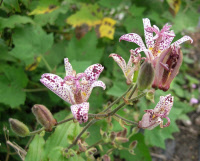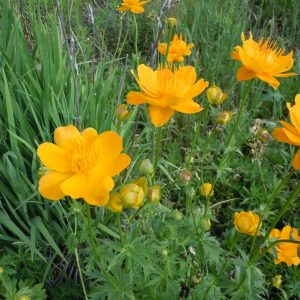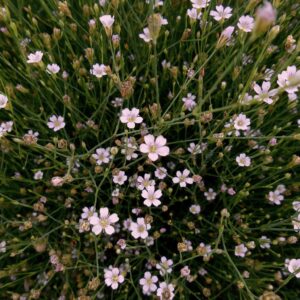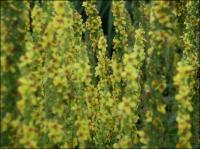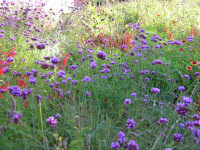Our Plants
Showing 561–568 of 587 results
-
Tricyrtis hirta Japanese Toad Lily, Hairy toadlily Zone 4 – 8
From August to October small clusters of flowers bloom, six white petals covered with purple spots as close as those of a leopard. These tend to self-seed around a bit.
From August to October small clusters of flowers bloom, six white petals covered with purple spots as close as those of a leopard. These tend to self-seed around a bit.
Size: 2-3' x 12"
Care: Moist well-drained soil in part shade to shade
Native: Japanese islands of Honshu, Shikoku and Kyushu
Awards: Oklahoma Proven 2010, Rated good by the Chicago Botanic GardenName Tricyrtis is Greek meaning “three cavities”, supposedly describing the outer petals. Originally collected for the West by Swedish Carl Pehr von Thunberg (1743-1828) who spent seven years collecting plants in South Africa, Japan, and Indonesia, Japan in 1775-1776.) Named by English botanist Sir Joseph Hooker in 1863. The Japanese name for this plant hototogisu, means “cuckoo” because the purple dots on the petals resemble the spots on the cuckoo bird’s chest.
-
Trollius europaeus Globe flower Z 5-8
Ball-shaped deep golden buds opening to nearly orange cups with prominent stamens from May to June & sporadically in September
Ball-shaped deep golden buds opening to nearly orange cups with prominent stamens from May to June & sporadically in September
Size: 18-24”x 24”
Care: Full sun to part shade in moist to wet soil
Native: Northern EuropeThe name Trollius is derived from the old Swiss-German word trol meaning “something round,” referring to the shape of the flower. Swedes used the fragrant drying flower petals for a strewing herb. Introduced to European gardens by the 1500’s and cultivated in America in the 1700’s. Grown in the Eichstätt Garden, the garden of Johann Konrad von Gemmingen, prince bishop of Eichstätt in Bavaria, c. 1600.
Grown by Thomas Jefferson.
-
Tunica saxifraga syn. Petrorhagia saxifraga Tunic flower Z 4-8
Free blooming pixie, palest of pink blossoms from June through October on wiry stems form a 4" tall mound.
Free blooming pixie, palest of pink blossoms from June through October on wiry stems form a 4″ tall mound.
Size: 6" x 8"
Care: Full sun in well-drained soil.
Native: Pyrenees and Alps
Wildlife Value: Drought tolerant.
Awards: Royan Horticultural Society Award of Merit.
Size: Perfect for rock gardens, front of borders or groundcover.Tunica is Latin meaning tunic or coat referring to overlapping bracts beneath the flower. Before 1753. Near 1900 William Robinson (1838-1935) described the Tunic flower as having “elegant little rosy flowers … a neat plant for the rock garden and fringes of borders and thrives like a weed between the stones in a rough stone wall.”
-
Umbilicus oppositifolius syn. Chiastophyllum oppositifolium Lamb’s tail Z 5-9
For shady gardens, a low mound of thick, succulent green leaves, bearing arching, upright stems with dangling chains of sulphur yellow flowers in May-June.
OUT OF STOCK
For shady gardens, a low mound of thick, succulent green leaves, bearing arching, upright stems with dangling chains of sulphur yellow flowers in May-June.
Size: 6-8” x 10-12”
Care: part shade in moist to moist well-drained soil
Native: Caucasus Mountains
Awards: Recipient Royal Horticultural Society Award of Garden Merit1st described and named as Cotyledon oppostitfoilum in Bulletin scientifique (publié par l’) Académie Imperiale des Sciences de Saint-Pétersbourg 2: 813. 1837.
-
Verbascum nigrum Dark mullein Self-seeding biennial Z 4-9
June to October (if deadheaded) 3’ fall spikes covered with five-petal flowers of canary yellow, spotlighting purple stamens at each flower’s center.
June to October (if deadheaded) 3’ fall spikes covered with five-petal flowers of canary yellow, spotlighting purple stamens at each flower’s center.
Size: 36" x 24"
Care: Sun well-drained soil - self-seeder
Native: Europe to SiberiaVerbascum was named by the Roman Pliny who said they attracted moths, calling them Moth mulleins. Cultivated in gardens as long ago as Medieval times. Favorite plant in Elizabethan cottage gardens in the 1500’s. Grown in the Eichstätt Garden, the garden of Johann Konrad von Gemmingen, prince bishop of Eichstätt in Bavaria, c. 1600. Described by Parkinson in 1629 as: “a stalke whereon stand many golden flowers with the like purple threads in the middle.”
-
Verbena bonariensis Perennial Z 7-10, colder zones-reseeding annual
Small purple flowers atop tall leafless stems from July to October. Great see-through blooms for growing in back, middle or front of the garden.
Small purple flowers atop tall leafless stems from July to October. Great see-through blooms for growing in back, middle or front of the garden.
Size: 3-4’ x 8”
Care: full sun in moist, well-drained, fertile soil - self-seeder
Native: South America
Awards: Royal Horticultural Society Award of Merit & Missouri Botanic Garden Plant of Merit.Introduced to garden cultivation from its native Buenos Aires in 1726 by the Sherard brothers.
-
Verbena hastata Blue vervain, Simpler’s joy Z 3-9
Bright purplish-blue candelabra-like spikes from July to September
Bright purplish-blue candelabra-like spikes from July to September
Size: 2-4’ x 2’
Care: sun to part shade in moist or moist well-drained soil
Native: eastern 2/3rds of No. America, Wisconsin native
Wildlife Value: Cardinals & Sparrows eat the seeds. Food for larvae of Buckeye butterfly.Native Americans used plant as remedy for coughs, colds, and fever. Mahuna Indians of So. California used the root to cure complicated stomach fevers. Sioux fed the seeds to their horses to give them energy. The Sioux also used it as an insect repellant. Pressed specimen in Emily Dickinson’s herbarium.
-
Vernonia fasciculata Prairie Ironweed Z 3-7
Dense clusters of fluffy petaled, true royal purple flowers atop unbranched stems, July-September
Dense clusters of fluffy petaled, true royal purple flowers atop unbranched stems, July-September
Size: 3-4’ x 2-3’
Care: sun to part shade in moist to moist well drained soil
Native: so central Canada to central & eastern US, Wisconsin native
Wildlife Value: Butterfly attractor – Fiery skipper. Host for Common buckeye butterfly. Deer & rabbit resistant.Lakota Sioux: “The leaves are formed into a sort of “plate” that keeps foreign matter from getting on meat. An infusion of the root is used to regulate menstrual periods.”
Collected by French planthunter André Michaux (1746-1802) who spent 11 years exploring America for plants. Vernonia named to honor Wm. Vernon (1666-1711) English botanist who collected plants in late 1600’s.

